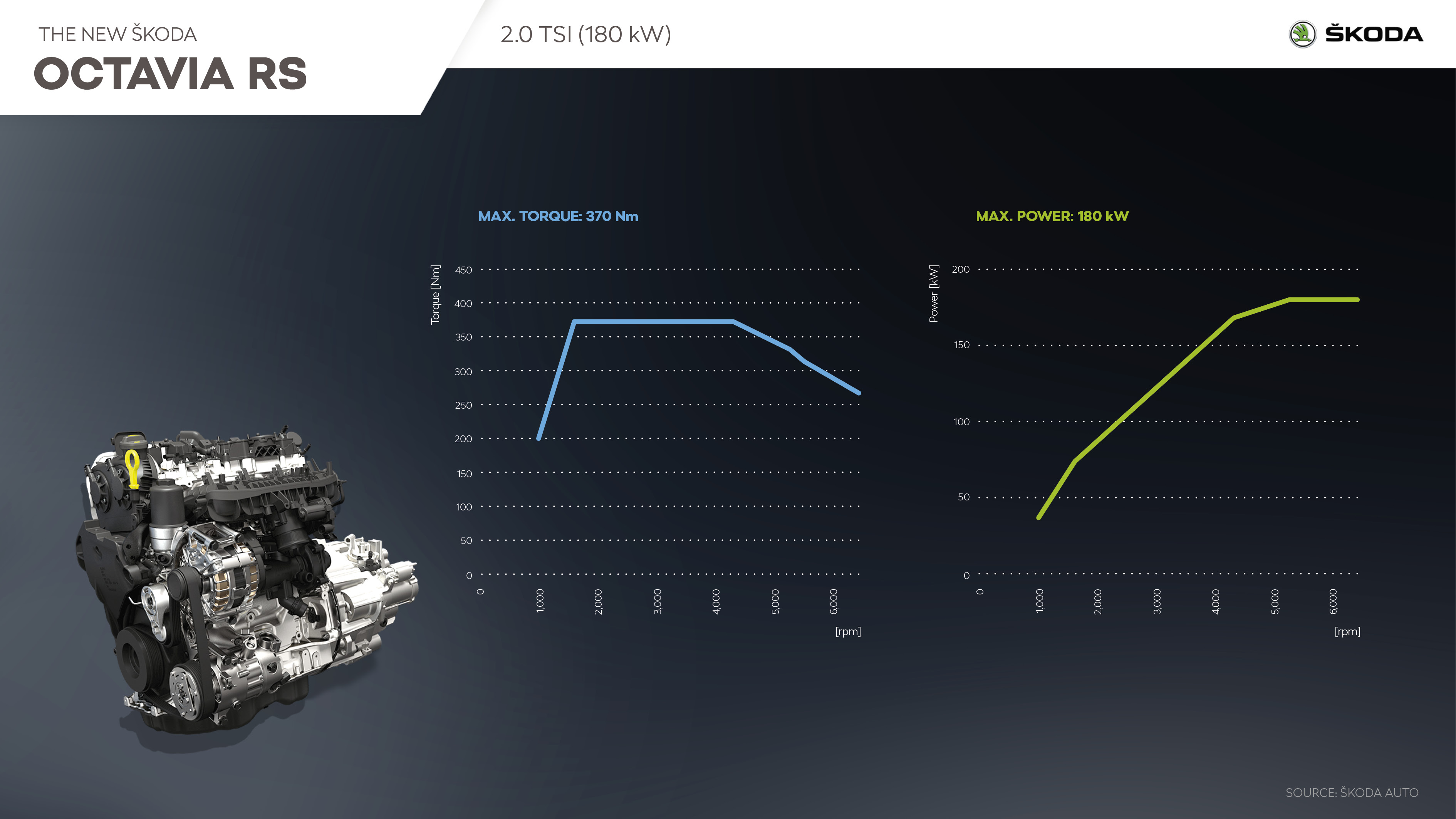› Dynamic and efficient: powerful EVO-generation petrol and diesel engines
› 2.0 TSI with electronic limited-slip differential and 2.0 TDI option with all-wheel drive including a new multi-plate clutch
› 15-mm-lower sports chassis as standard, with adaptive DCC option
ŠKODA’s line-up of the OCTAVIA RS now consists of a sporty trio. Following the launch of the OCTAVIA RS iV as the first RS model to feature plug in hybrid drive, the compact sports car can now be ordered with either the biggest petrol engine or the most powerful diesel in the range. As with the OCTAVIA RS iV plug in hybrid, the latest EVO-generation 2.0 TSI delivers 180 kW (245 PS). The 2.0 TDI’s power output is 147 kW (200 PS).
Engines available for the current OCTAVIA RS at a glance:
| Engine | 2.0 TSI | 2.0 TDI | |||
| Max. power output | [kW] | 180 | 147 | ||
| [PS] | 245 | 200 | |||
| Max. torque [Nm] | 370 | 400 | |||
| Transmission | 6-speed M | 7-speed DSG | 7-speed DSG | 7-speed DSG | |
| Drive | Front-wheel | Front-wheel | Front-wheel | All-wheel | |
| Top speed [km/h] | 250 | 250 | 249 (245) | 243 (238) | |
| Acceleration 0–100 km/h [s] |
6.8 | 6.7 | 7.4 | 6.8 | |
() Applies to COMBI
When fitted with all-wheel drive and a 2.0 TDI engine delivering 147 kW (200 PS), the OCTAVIA RS can tow a braked trailer weighing up to 2,000 kg. The front-wheel-drive ŠKODA OCTAVIA RS has a fuel capacity of 50 l, which is 5 l more than the standard OCTAVIA variant can hold. The fuel tank of the all-wheel-drive OCTAVIA RS can even hold 55 l.
Product footage for media
Comprehensive modifications for the new EVO engines
The new 2.0 TSI engine of the ŠKODA OCTAVIA RS is based on the power unit of the previous generation’s OCTAVIA RS 245. Further development of the engine focused on maintaining its dynamic characteristics and maximum output of 180 kW (245 PS) while making it even more efficient. This was achieved, among other things, by increasing the fuel injection pressure up to 350 bar, and by using newly shaped piston crowns and a new crankshaft seal to reduce friction and, therefore, fuel consumption. Furthermore, the ŠKODA engineers modified the exhaust gas routing as well as the ignition system.
The technology of the 2.0 TDI delivering 147 kW (200 PS) is similar to that of the other EVO generation diesels, producing either 85 kW (116 PS) or 110 kW (150 PS). The 2.0 TDI features, however, an aluminium cylinder block and aluminium pistons with low-friction piston rings. In addition to that, it comes with different connecting rods, where the diameter of the journals is now 54 instead of 48 mm. The turbocharger is water-cooled for improved temperature regulation, and its compression ratio is higher.
Increased driving dynamics with a limited-slip differential, all-wheel drive to react within fractions of a second
The OCTAVIA RS fitted with a TSI engine comes with an electronic limited-slip differential as standard, providing more traction and even greater driving dynamics. The sixth-generation electro‑hydraulic multi-plate clutch achieves a maximum lock-up torque of 1,600 Nm. The XDS+ function, which is a standard feature in other OCTAVIA models, has a locking torque of 500 Nm. The limited-slip differential works in the Normal and Sport modes, which can be accessed in Driving Mode Select.
The all-wheel-drive system – which is available as an option for the OCTAVIA RS fitted with a TDI engine – distributes power via a new, electronically controlled sixth-generation multi-plate clutch. This clutch is nearly 0.8 kg lighter than its predecessor and is more efficient thanks to the use of low-friction oil, reduced bearing preload and refined internal lubrication. The new piston pump is driven by a brushless DC electric motor which features an integrated control unit to increase the clutch’s performance as well as its lifespan. The control electronics of the all‑wheel‑drive system react to changing driving conditions within fractions of a second and boost the driving dynamics, for example when cornering fast. The system transfers part of the driving torque to the opposite wheel when the load on the inner wheel is reduced, and maintains traction. In the 2.0 TDI OCTAVIA RS models that do not feature Dynamic Chassis Control, the driver can set the characteristics of the XDS+ system to Normal or Sport using Driving Mode Select. XDS+ is an extension of the electronic differential lock (EDL) and improves traction.
Sports suspension as standard, with adaptive Dynamic Chassis Control option
The RS-typical sports chassis, which comes as standard, lowers the car by 15 mm. Adaptive Dynamic Chassis Control (DCC) is an optional extra. It constantly adjusts the damping and enables a particularly dynamic driving style in Sport mode. Using slider controls on the 10-inch central touchscreen in Driving Mode Select, it is now possible to adjust DCC parameters such as damping, steering characteristics or the operation of the DSG (direct-shift gearbox) – this is a first. The multi‑link rear axle distinguishes itself by providing high levels of comfort and good handling. The 2.0 TSI’s 17-inch diameter brakes ensure optimum deceleration. The 2.0 TDI has been fitted with 16-inch brakes at the front and 15-inch brakes at the rear.

Hermann Prax
Head of Product Communications
T +420 734 298 173
hermann.prax@skoda-auto.cz
Zbyněk Straškraba
Product Communications
T +420 326 811 785
zbynek.straskraba@skoda-auto.cz


























